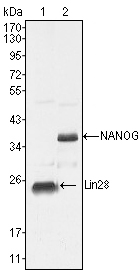Nanog Monoclonal Antibody
- Catalog No.:YM0464
- Applications:WB;IF;ELISA
- Reactivity:Human
- Target:
- Nanog
- Fields:
- >>Signaling pathways regulating pluripotency of stem cells;>>Proteoglycans in cancer
- Gene Name:
- NANOG
- Protein Name:
- Homeobox protein NANOG
- Human Gene Id:
- 79923
- Human Swiss Prot No:
- Q9H9S0
- Mouse Swiss Prot No:
- Q80Z64
- Immunogen:
- Purified recombinant fragment of Nanog (aa20-166) expressed in E. Coli.
- Specificity:
- Nanog Monoclonal Antibody detects endogenous levels of Nanog protein.
- Formulation:
- Liquid in PBS containing 50% glycerol, 0.5% BSA and 0.02% sodium azide.
- Source:
- Monoclonal, Mouse
- Dilution:
- WB 1:500 - 1:2000. IF 1:200 - 1:1000. ELISA: 1:10000. Not yet tested in other applications.
- Purification:
- Affinity purification
- Storage Stability:
- -15°C to -25°C/1 year(Do not lower than -25°C)
- Other Name:
- NANOG;Homeobox protein NANOG;Homeobox transcription factor Nanog;hNanog
- Molecular Weight(Da):
- 35kD
- References:
- 1. Genes Cells. 2006 Sep;11(9):1115-23.
2. Mol Biol Cell. 2007 May;18(5):1543-53.
- Background:
- The protein encoded by this gene is a DNA binding homeobox transcription factor involved in embryonic stem (ES) cell proliferation, renewal, and pluripotency. The encoded protein can block ES cell differentiation and can also autorepress its own expression in differentiating cells. Two transcript variants encoding different isoforms have been found for this gene. [provided by RefSeq, Sep 2015],
- Function:
- developmental stage:Expressed in embryonic stem (ES) and carcinoma (EC) cells. Expressed in inner cell mass (ICM) of the blastocyst and gonocytes between 14 and 19 weeks of gestation (at protein level). Not expressed in oocytes, unfertilized oocytes, 2-16 cell embryos and early morula (at protein level). Expressed in embryonic stem cells (ES). Expression decreases with ES differentiation.,function:May act as a transcription regulator (By similarity). When overexpressed, promotes cells to enter into S phase and proliferation.,function:Transcription regulator involved in inner cell mass and embryonic stem (ES) cells proliferation and self-renewal. Imposes pluripotency on ES cells and prevents their differentiation towards extraembryonic endoderm and trophectoderm lineages. Blocks bone morphogenetic protein-induced mesoderm differentiation of ES cells by physically interacting with SMAD1 an
- Subcellular Location:
- Nucleus .
- Expression:
- Expressed in testicular carcinoma and derived germ cell tumors (at protein level). Expressed in fetal gonads, ovary and testis. Also expressed in ovary teratocarcinoma cell line and testicular embryonic carcinoma. Not expressed in many somatic organs and oocytes.
Identification of MAEL as a promoter for the drug resistance model of iPSCs derived from T-ALL. Cancer Medicine. Human 1:500 iPSCs
Single cell derived spheres of umbilical cord mesenchymal stem cells enhance cell stemness properties, survival ability and therapeutic potential on liver failure. BIOMATERIALS 2019 Oct 21 WB Human Umbilical cord mesenchymal stem cells (UCMSCs)
Prolonged inhibition of class I PI3K promotes liver cancer stem cell expansion by augmenting SGK3/GSK-3β/β-catenin signalling. JOURNAL OF EXPERIMENTAL & CLINICAL CANCER RESEARCH 2018 Jun 25 WB,IF Human MHCC-97H cell,Huh7 cell
FEN1 upregulation mediated by SUMO2 via antagonizing proteasomal degradation promotes hepatocellular carcinoma stemness Translational Oncology Zhenxiang Peng WB Human Huh7 cell,MHCC-97H cell
- June 19-2018
- WESTERN IMMUNOBLOTTING PROTOCOL
- June 19-2018
- IMMUNOHISTOCHEMISTRY-PARAFFIN PROTOCOL
- June 19-2018
- IMMUNOFLUORESCENCE PROTOCOL
- September 08-2020
- FLOW-CYTOMEYRT-PROTOCOL
- May 20-2022
- Cell-Based ELISA│解您多样本WB检测之困扰
- July 13-2018
- CELL-BASED-ELISA-PROTOCOL-FOR-ACETYL-PROTEIN
- July 13-2018
- CELL-BASED-ELISA-PROTOCOL-FOR-PHOSPHO-PROTEIN
- July 13-2018
- Antibody-FAQs
- Products Images

- Western Blot analysis using Nanog Monoclonal Antibody against NTERA-2 cell lysate (2).

- Confocal immunofluorescence analysis of NTERA-2 cells (left) and HeLa cells (right) using Nanog Monoclonal Antibody (green). Red: Actin filaments have been labeled with DY-554 phalloidin.



